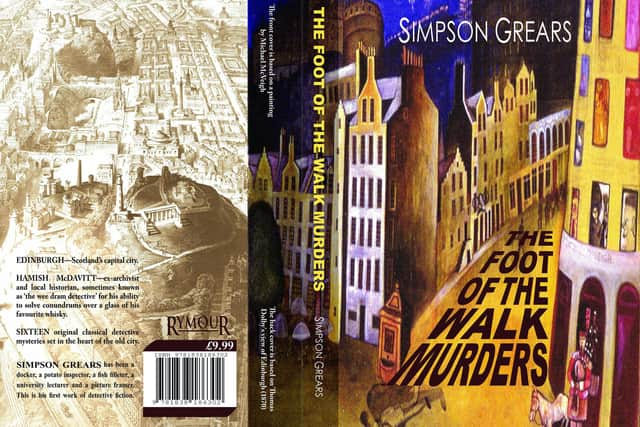The Foot of the Walk Murders, by Simpson Grears, Pt 3: But was Johnny Monkey guilty?


Lambie had solved the case by sheer hard detective work, pounding the streets and interviewing prostitutes, dockers, mollycoddlers; anyone who might have observed the least thing. Lambie had a formidable reputation as an Edinburgh detective, tireless, dedicated, unafraid to enter even the most debauched den of the dark side of the city. He was reputedly equally respected and feared by both his own colleagues and the criminal underworld of Edinburgh.
It was said that he had personally arrested half the criminals brought to justice in the 80s and had rid the city forever of the scourge of baby- farming. It was also reported that, not content to sit at his desk and await the results of his investigations, he disguised himself as a tramp or a beggar and trod the streets himself seeking informants. For this and other reasons, he was also sometimes mooted as a model for Conan Doyle’s Sherlock Holmes.
Advertisement
Hide AdAdvertisement
Hide AdThrough his endeavours, Lambie had traced the source of the affair to a Lascar sailor named Johnny Syed but commonly known as Johnny Monkey, who, it had been revealed, had been seen near the scene of the first two crimes. On the day of the final murder, Lambie had also discovered that the suspect was wanted for similar crimes in another seaport. He had sent a squad to the suspect’s lodgings to arrest him, but Johnny Monkey had felt the hot breath of the hounds of justice and had hanged himself before they arrived.


The evidence of Johnny Monkey’s guilt, even though purely circumstantial, was universally accepted and no further such murders took place in Leith for some time – not, in fact, until the Tower Bar Taproom affair of 1908.
‘The rest of the book,’ said Hamish, ‘puts together a rather unconvincing case for another perpetrator, but as usual, relies on the old ploy of an establishment cover-up to protect a respectable gentleman.’
‘As if the police had enough time – as well as the sheer lack of integrity – to spend half their time covering up for the failings of the upper classes,’ sighed Ord, who both favoured and loyally supported his own policemen while discreetly maintaining a veiled contempt for the Edinburgh establishment and their machinations.
Advertisement
Hide AdAdvertisement
Hide AdThe True Story of the Edinburgh Ripper claimed that the murders were actually committed by a supposedly respectable Edinburgh physician, lain Ewing Valentine, who was vaguely related to the Duke of Buccleuch. There were three main arguments to the case against Valentine: Firstly, his profession had resulted in him spending a great deal of time in the vicinity of the murders. Secondly, he would have carried a knife that would have been suitable for the commission of the crimes. Thirdly, and crucially according to the book, he had been carrying out a specialist branch of his profession (that involved meeting a great many women) that had been relatively common at the time but little known about today.
In fact, to illustrate this, Peers-David included the page of a pamphlet that advertised ‘the latest and most pertinent treatment for hysteria, pelvic hyperemia and congestion of the genitalia; carried out with the revolutionary patented vibrating machine and applied under full medical supervision.’
‘What exactly was wrong with these women?’ asked Ord Hamish allowed himself a little chuckle.
‘Largely nothing at all, or what we nowadays call sexual frustration. It was not uncommon practice for doctors to attend to women – mostly married women – in this way. Invariably they would do it conscientiously and exercise discretion despite what the more sensationalist accounts may say.’
Advertisement
Hide AdAdvertisement
Hide Ad‘So could this have any connection with the sexual perversions of the murderer?’
Hamish’s brow creased for a moment, but then there was a little shake of his head. ‘Whatever we may think about the legitimacy of these methods, it’s hard to see what the connection is. Can we really acquaint giving women pleasure with brutally murdering them!
‘And, besides, the women victims of these crimes could hardly afford that sort of exclusive treatment.’
‘Has it any relevance, then?’
Hamish smiled: ‘Only, I would suggest, of making the book a little more interesting for the reader!’
Advertisement
Hide AdAdvertisement
Hide Ad‘Which... ’ Ord added, ‘is only too commonplace these days!’
Secondly, the author had examined all of Valentine’s recorded correspondence which he had discovered in the National Library and he had seemingly unearthed evidence for his crimes – coded in anagram form within the letters!
For example, one letter seemed to deal with his purchase of crab meat from the harbour at Newhaven and Peers-David had selected a couple of sentences: ‘I have the taste for partan meat... Do send aunt a live one... ’
This had been sorted to read: ‘I have a taste for meat… Anne Sloan d(eceased) due to I. E. V. [lain Ewing Valentine]’.
Advertisement
Hide AdAdvertisement
Hide Ad‘Sheer nonsense,’ ejaculated Ord, and Hamish nodded in fervent agreement. ‘I’ve seen this sort of trickery a couple of times before, but it’s just a game and means nothing. It must have taken Peers-David some time to work out these convoluted puzzles, but anyone could do it if they worked hard enough.’
The third part of the argument, however, was a little more interesting. There were a couple of mentions in the police investigation into the case of the last victim, Mary McCutcheon, of a hitherto unconsidered piece of evidence. Apparently, in the last days before her sudden death, she had been noticed wearing a ring with the initials IV. Finally, on top of this, there was a suggestion that McCutcheon had been examined by a physician appointed by her family in the early days of her pregnancy and, although there was no direct evidence, Peers-David harnessed some reasonably convincing secondary sources to suggest it may have been Valentine himself.
Tomorrow: The search for the Ripper is on